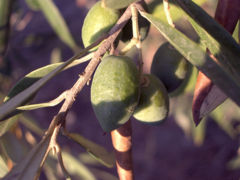Olea: Difference between revisions
Created page with '{{SPlantbox |genus=Olea |Temp Metric=°F |jumpin=If this plant info box on watering; zones; height; etc. is mostly empty you can click on the edit tab and fill in the blanks! |im…' |
No edit summary |
||
| Line 1: | Line 1: | ||
{{SPlantbox | {{SPlantbox | ||
|familia=Oleaceae | |||
|genus=Olea | |genus=Olea | ||
|taxo_author=L. | |||
|Temp Metric=°F | |Temp Metric=°F | ||
|jumpin=If this plant info box on watering; zones; height; etc. is mostly empty you can click on the edit tab and fill in the blanks! | |jumpin=If this plant info box on watering; zones; height; etc. is mostly empty you can click on the edit tab and fill in the blanks! | ||
|image= | |image=Olive-tree-fruit-august-0.jpg | ||
|image_width=240 | |image_width=240 | ||
|image_caption=''Olea europaea'' (Olive) | |||
}} | }} | ||
'''''Olea''''' ({{pron-en|ˈoʊliːə}})<ref>''Sunset Western Garden Book,'' 1995:606–607</ref> is a [[genus]] of about 20 species in the family [[Oleaceae]], native to warm temperate and tropical regions of southern [[Europe]], [[Africa]], southern [[Asia]] and [[Australasia]]. They are [[evergreen]] [[tree]]s and [[shrub]]s, with small, opposite, entire [[leaf|leaves]]. The [[fruit]] is a [[drupe]]. | |||
For humans, the most important species is by far the [[Olive]] (''Olea europaea''), native to the [[Mediterranean]] region. ''O. paniculata'' is a larger tree, attaining a height of 15-18 m in the forests of [[Queensland]], and yielding a hard and tough [[timber]]. The yet harder wood of the [[Black Ironwood]] ''O. laurifolia'', an inhabitant of [[KwaZulu-Natal Province|Natal]], is important in [[South Africa]]. | |||
{{Inc| | {{Inc| | ||
Olea (classical name for olive). Oleaceae. Olive. The olive tree and fruit; and other small trees or shrubs of little importance in cultivation. (The Olea fragrans of greenhouses is Osmanthus; also O. Aquifolium.) | Olea (classical name for olive). Oleaceae. Olive. The olive tree and fruit; and other small trees or shrubs of little importance in cultivation. (The Olea fragrans of greenhouses is Osmanthus; also O. Aquifolium.) | ||
| Line 21: | Line 28: | ||
== | ==Species== | ||
;Selected species | |||
*''[[Olea brachiata]]'' | |||
*''[[Olea capensis]]'' (Small Ironwood) | |||
*''[[Olea caudatilimba]]'' | |||
*''[[Olea chryssophylla]]'', a wild olive of Asia and Africa | |||
*''[[Olive|Olea europaea]]'' (Olive) | |||
*''[[Olea exasperata]]'' (Dune Olive) | |||
*''[[Olea guangxiensis]]'' | |||
*''[[Olea hainanensis]]'' | |||
*''[[Olea laurifolia]]'' (Black Ironwood) | |||
*''[[Olea laxiflora]]'' | |||
*''[[Olea neriifolia]]'' | |||
*''[[Olea oleaster]]'', a wild olive whose cultivar "Olivastro" is used as rootstock for ''O. europaea''; formerly classified as the subspecies ''O. europaea oleaster'' | |||
*''[[Olea paniculata]]'' | |||
*''[[Olea parvilimba]]'' | |||
*''[[Olea rosea]]'' | |||
*''[[Olea salicifolia]]'' | |||
*''[[Olea sylvestris]]'', a small-fruited wild olive of the Mediterranean region, sometimes used as rootstock for ''O. europaea''. | |||
*''[[Olea tetragonoclada]]'' | |||
*''[[Olea tsoongii]]'' | |||
*''[[Olea undulata]]'' | |||
*''[[Olea woodiana]]'' (Forest Olive) | |||
==Gallery== | ==Gallery== | ||
Latest revision as of 20:18, 22 February 2010
| Olea subsp. var. | ||||||||||||||||||||||||||||||||||||||||||||||||||||||||
|---|---|---|---|---|---|---|---|---|---|---|---|---|---|---|---|---|---|---|---|---|---|---|---|---|---|---|---|---|---|---|---|---|---|---|---|---|---|---|---|---|---|---|---|---|---|---|---|---|---|---|---|---|---|---|---|---|

|
|
| ||||||||||||||||||||||||||||||||||||||||||||||||||||||
| ||||||||||||||||||||||||||||||||||||||||||||||||||||||||
Olea (pronounced /ˈoʊliːə/)[1] is a genus of about 20 species in the family Oleaceae, native to warm temperate and tropical regions of southern Europe, Africa, southern Asia and Australasia. They are evergreen trees and shrubs, with small, opposite, entire leaves. The fruit is a drupe.
For humans, the most important species is by far the Olive (Olea europaea), native to the Mediterranean region. O. paniculata is a larger tree, attaining a height of 15-18 m in the forests of Queensland, and yielding a hard and tough timber. The yet harder wood of the Black Ironwood O. laurifolia, an inhabitant of Natal, is important in South Africa.
| Standard Cyclopedia of Horticulture |
|---|
|
Olea (classical name for olive). Oleaceae. Olive. The olive tree and fruit; and other small trees or shrubs of little importance in cultivation. (The Olea fragrans of greenhouses is Osmanthus; also O. Aquifolium.) Spiny or unarmed: Lvs. evergreen and thick, opposite, usually entire, and often rusty-tomentose beneath: fls. small, usually imperfect, white or whitish, in forking panicles or fascicles, the short calyx 4-toothed (corolla sometimes none), the short-tubed corolla with 4 valvate lobes, the stamens 2; ovary 2-loculed, bearing a short style and capitate stigma: fr. an oblong or ovoid drupe.—Between 30 and 40 trees or shrubs of the tropical and warm-temperate parts of the Old World to New Zeal.
|
Cultivation
Propagation
Pests and diseases
Species
- Selected species
- Olea brachiata
- Olea capensis (Small Ironwood)
- Olea caudatilimba
- Olea chryssophylla, a wild olive of Asia and Africa
- Olea europaea (Olive)
- Olea exasperata (Dune Olive)
- Olea guangxiensis
- Olea hainanensis
- Olea laurifolia (Black Ironwood)
- Olea laxiflora
- Olea neriifolia
- Olea oleaster, a wild olive whose cultivar "Olivastro" is used as rootstock for O. europaea; formerly classified as the subspecies O. europaea oleaster
- Olea paniculata
- Olea parvilimba
- Olea rosea
- Olea salicifolia
- Olea sylvestris, a small-fruited wild olive of the Mediterranean region, sometimes used as rootstock for O. europaea.
- Olea tetragonoclada
- Olea tsoongii
- Olea undulata
- Olea woodiana (Forest Olive)
Gallery
-
photo 1
-
photo 2
-
photo 3
References
- ↑ Sunset Western Garden Book, 1995:606–607
- Standard Cyclopedia of Horticulture, by L. H. Bailey, MacMillan Co., 1963
External links
- w:Olea. Some of the material on this page may be from Wikipedia, under the Creative Commons license.
- Olea QR Code (Size 50, 100, 200, 500)
